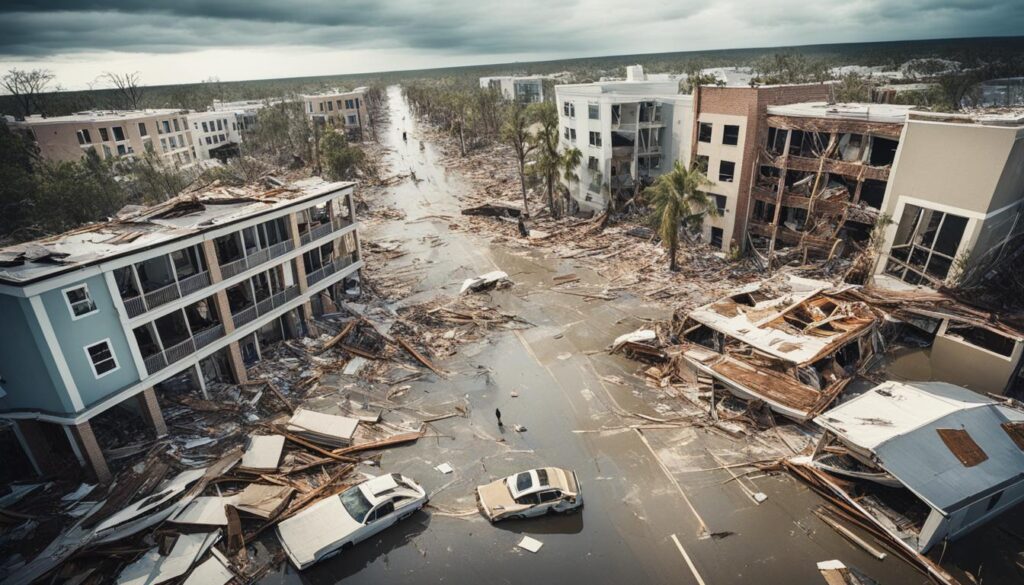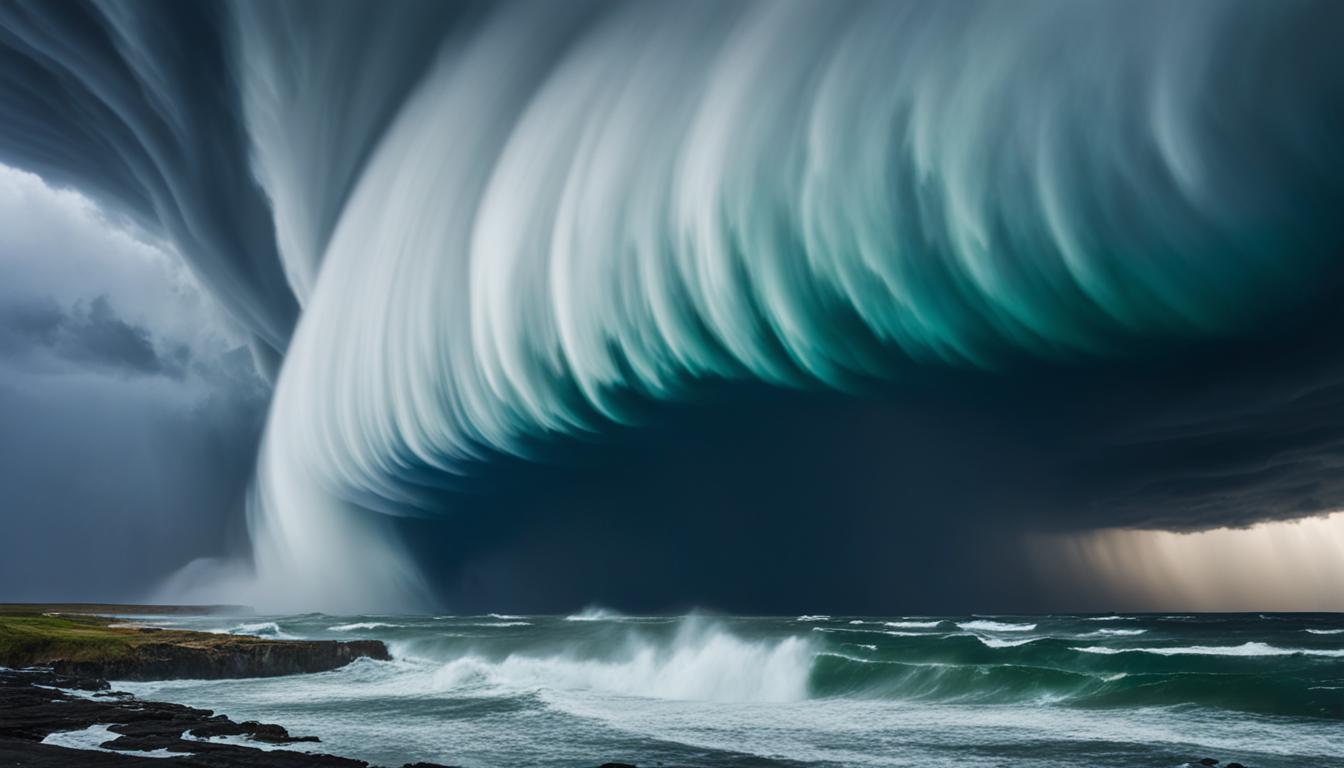Our planet is getting warmer because of climate change, and hurricanes are getting worse. Over the years, big hurricanes are getting stronger and causing more damage. At the same time, small hurricanes are happening less often1. This change is because warmer oceans give hurricanes more energy, making them stronger and faster12. Also, rising sea levels make storm surges worse, causing floods that can destroy coastal areas1.
Key Takeaways
- Hurricanes are becoming more intense due to climate change, with an increase in Category 4 and 5 storms.
- Warmer ocean temperatures are providing more energy to fuel hurricanes, leading to higher wind speeds and increased rainfall.
- Rising sea levels are worsening the impacts of storm surges, leading to more severe coastal flooding.
- Hurricanes are moving more slowly, subjecting coastal regions to longer periods of high winds, heavy rain, and storm surge.
- The frequency and intensity of hurricanes in the North Atlantic have increased in recent decades.
Warmer Ocean Temperatures Fuel Stronger Hurricanes
The Earth’s oceans have taken in over 90% of the extra heat from human activities3. This has made ocean temperatures rise, giving hurricanes more energy and strength3. Since 1900, the global sea level has gone up by half a foot, with most of that happening since 19703. This warming is making hurricanes stronger, as the most damaging ones in the U.S. are now three times more common than they used to be3.
Over 90% of Earth’s Excess Heat Absorbed by Oceans
Oceans are now the main places where the Earth’s heat goes3. Because of this, the number of major hurricanes (Category 3 or above) in the Atlantic has doubled since 19803. Hurricanes in the Atlantic are getting stronger faster since the 1980s because of climate change3. Also, hurricanes are moving slower now, which can cause more damage. This is because slower winds that guide hurricanes in a warmer world might be the reason3.
Warmer Waters Provide More Energy for Hurricanes
Climate change makes sea surface temperatures warmer, giving hurricanes more energy and fuel to grow stronger4. For example, Hurricane Beryl became a Category 5 storm with 150 mph winds after hitting the Eastern Caribbean, which was the earliest such event in the Atlantic4. Warmer water makes hurricanes intensify quickly, raising the chance of major hurricanes forming in recent years4. As temperatures keep rising, experts predict more hurricanes in the future, highlighting the need for early action and prevention4.
“Warmer ocean temperatures driven by climate change are providing more energy and fuel for hurricanes to intensify, leading to more damaging storms. As global temperatures continue to rise, we can expect to see an increase in the frequency and intensity of these extreme weather events.” – Dr. Emily Marshall, Climate Scientist
The link between warmer oceans and stronger hurricanes is clear5. Hurricane Beryl grew from a weak tropical depression to a major hurricane in less than two days, showing the impact of record-breaking water temperatures in the tropical Atlantic5. Climate change might be changing how hurricanes quickly get stronger, as the oceans’ extra heat fuels these storms5. The 2024 hurricane forecast predicts the most storms ever, mainly because of record-breaking ocean temperatures5.
Rising Air Temperatures Intensify Rainfall
As air temperatures rise due to climate change, the effects on hurricane rainfall and flood risks are worrying6. Hurricanes with winds over 74 miles per hour can make more rain and increase wind speeds, causing more flooding and storm surges6. Even though storms might not come more often, the ones that do will likely be stronger, possibly leading to more Category 4 or 5 storms6.
Hotter Air Holds More Moisture, Increasing Flood Risks
Warmer air can hold more moisture, which is why we’re seeing this trend7. For every 1 degree Celsius rise in temperature, the air can hold 7% more moisture7. This means hurricanes will get wetter and more intense as the planet warms up7. A study showed Hurricane Harvey in 2017 brought record rainfall, happening once every 9,000 years, with warming playing a big role7.
Now, we’re seeing more and more flooding from hurricanes8. Tropical cyclones are expected to make 10-15% more rain in a 2-degree Celsius warmer world, and more storms will reach very intense levels8. We need a strong plan to build resilience and fight the effects of climate change on hurricanes8.
Sea Level Rise Exacerbates Storm Surge Threats
As the planet warms, sea levels are rising, especially in coastal areas9. Coastal regions in the Southeast face threats from sea level rise and stronger hurricanes. By the end of this century, sea levels could rise more quickly9. This rise affects not just low-lying nations but also coastal communities worldwide. It increases the risks from storm surges with hurricanes and other storms.
Global sea levels have risen over half a foot since 1900 and are expected to rise another 1 to 2.5 feet this century10. This rise means storm surges can go farther inland, causing more damage and flooding10. For example, higher sea levels added $2 billion in damage to New York City after Hurricane Sandy11.
| Coastal Region | Projected Sea Level Rise by 2100 | Potential Impacts |
|---|---|---|
| Southeast United States | 1-2.5 feet | Increased storm surge, coastal flooding, ecosystem damage |
| East and Gulf Coasts | 1-2.5 feet | More frequent and severe storm impacts, infrastructure damage |
| Small Island Nations | 1-2 feet | Submersion of low-lying areas, population displacement |
As sea levels keep rising, the threat of storm surge and coastal flooding gets worse10. It’s crucial to prepare and adapt to these challenges ahead11.
“Combining rising sea levels and storm intensity means storms previously passing unnoticed can become major threats, especially in quick succession.”
Sea level rise and its effect on storm surges show we need strong strategies to deal with climate change’s impact on coasts11. By understanding the risks and acting early, communities can prepare for and lessen the threats from this big environmental issue91011.
Slowing Atmospheric Currents Prolong Hurricane Impacts
As the Earth gets warmer, scientists have found a worrying trend: global warming is weakening the winds that move weather systems, like hurricanes, around the world12. This means hurricanes and tropical storms stay in one place longer, causing more rain and strong winds12. These storms are now causing more damage because they last longer and are stronger12.
Sluggish Storms Linger Longer, Dumping Excessive Rainfall
Studies show that hurricanes today move slower than they used to13. This means coastal areas are under attack from strong winds, heavy rains, and a big storm surge for a longer time13. Scientists think the warming climate is making the winds that guide hurricanes move slower, so storms stay put and pour out a lot of rain14.
Hurricane Harvey in 2017 was a perfect example of this. It moved very slowly over Texas, causing record-breaking rain that flooded huge areas13. Experts say climate change made Harvey dump at least 18% more rain than usual13. Since the 1980s, storms that get stuck have been bringing twice as much rain as before13.

With sea levels rising, the threat from hurricanes is getting worse13. Storms that stay longer and sea levels higher mean bigger storm surges, putting coastal areas at great risk13.
“Hurricanes and tropical storms have slowed in forward motion over the continental U.S. since 1900.”12
As the planet gets warmer, we can expect more intense, slow-moving hurricanes with a lot of rain and storm surge121314. It’s important for coastal communities to adapt to these changes to stay safe in the future.
hurricane climate changes Trends and Projections
The number of hurricanes in the news each year might seem to be going up. But, the Intergovernmental Panel on Climate Change (IPCC) says there’s no global trend of more hurricanes over the past century15. They do think storms that land might be more intense—category 4 or 5—with more rain and wind15.
No Global Increase in Hurricane Frequency Yet
The IPCC says there’s no overall increase in hurricanes worldwide. But, they have seen more hurricanes in the North Atlantic, both in number and strength16. Researchers found the most damaging U.S. hurricanes are now three times more common than a century ago. Also, major hurricanes in the Atlantic Ocean have doubled since 198017.
But More Intense Hurricanes Expected in the Future
Scientists are studying how climate change affects hurricane strength, speed, and how often they occur15. There are about 80 tropical cyclones each year, but it’s hard to predict if this will change15. The IPCC believes more intense storms are likely, with more Category 4 and 5 hurricanes16. Climate change also means sea levels rise, making storm surges and flooding worse15.
Studies using satellites and computers look at how climate change affects extreme weather like hurricanes15. They show tropical cyclones moving towards the poles and more major hurricanes in the Atlantic, thanks to warmer oceans15.
“Reliable scientific information on potential future changes in tropical cyclone activity can assist in decision-making for climate change mitigation and adaptation efforts in hurricane-prone regions.”
Contributing Factors and Mechanisms
As the climate warms, scientists are looking into how climate change affects hurricane patterns18. They found that the Arctic and mid-latitudes warming might change how these storms behave18. This could make hurricanes move slower and get stronger at higher latitudes, threatening more people and property.
Warming Arctic and Mid-Latitudes Influencing Storm Patterns
The Arctic and mid-latitudes warming could change hurricane paths1819. This warming changes the atmosphere, making hurricanes move differently and get stronger1819.
- Hurricanes may move slower, causing more flooding18.
- Storms could get stronger at higher latitudes, affecting more coastal areas18.
Researchers are still figuring out why these changes happen, but the link between warming and hurricane patterns is key1819. They’re working to understand how climate change affects hurricanes, to help us prepare and protect ourselves.
“The warming of the Arctic and mid-latitudes may be contributing to other trends seen in the hurricane record, such as hurricanes traveling more slowly and a northward shift in the location at which storms reach their peak intensity.”18
As we learn more about these factors, it’s crucial to stay updated and ready for climate’s effects on hurricanes181920.
Defining Hurricanes and Their Categorization
Hurricanes are powerful storms that form over warm ocean waters near the equator21. They bring thunderstorms, strong winds, and heavy rain, causing damage to coastal areas17. The National Hurricane Center uses the Saffir-Simpson Hurricane Wind Scale to categorize them by wind speed.
The scale goes from Category 1, with winds of 74-95 mph, to Category 5, with winds over 157 mph22. Hurricanes in Category 3 or higher, with winds over 111 mph, are very dangerous and can cause a lot of damage22. Recently, more major hurricanes have been happening, making storms stronger21.
Knowing how hurricanes are categorized helps us understand their dangers and prepare for them22. In South Florida, some hurricanes have been Category 1, while others have been Category 222. Category 3 hurricanes have also hit, causing a lot of damage.
The worst hurricanes, in categories 4 and 5, have caused the most damage in South Florida22. These include the 1888, 1900, 1919, 1926 Great Miami, 1928 Lake Okeechobee/Palm Beach, 1947, and Donna of 1960 hurricanes, as well as the Keys Hurricane of 1935 and Andrew of 199222.
As climate change affects hurricanes, it’s important to understand them better21. We need to stay informed and prepared to protect lives and property from these powerful storms.
Growing Threats: Financial Costs and Public Safety
Climate change is making hurricanes more dangerous, raising financial costs and public safety risks23. Sea levels and storm surges threaten coastal areas, buildings, and properties23. These threats can damage important infrastructure in coastal U.S. areas23. Also, heat waves and high temperatures may harm railways, roads, and power systems in Western States.
Coastal Development Increases Property Risk
More hurricanes and coastal growth mean more property risks24. From 2018 to 2022, major U.S. weather and climate disasters cost over $617 billion24. In 2022, these disasters cost more than $176 billion, making it the third most expensive year24. 13% of Americans faced economic problems from disasters or severe weather last year.
Disruptions to Infrastructure and Public Health
Hurricanes threaten property, public health, and key infrastructure23. Climate change affects U.S. national security by changing stability, politics, and access to resources23. It could also affect military operations, needing more disaster preparedness23. Rising sea levels and storm surges pose big risks to coastal transportation.
25 About two-thirds of American homes are not fully insured, leaving millions facing big financial losses after disasters25. Floods caused $120 billion in insured losses worldwide in 2022, affecting insurance markets in the U.S. east coast, especially Florida.
The threats from hurricanes will get worse, making it crucial to plan for resilience and adaptation.

Building Resilience Against Hurricane Impacts
Climate change makes hurricanes more intense and frequent. Coastal areas must focus on building resilience to protect homes, businesses, and infrastructure26. This can be done by preserving natural barriers, enhancing infrastructure, and updating building codes and evacuation plans.
Preserving Natural Buffers and Improving Infrastructure
Coastal wetlands, dunes, and reefs are key in absorbing storm surges and reducing hurricane damage27. Keeping these natural barriers safe helps protect communities from hurricane effects. Also, investing in strong infrastructure like seawalls and drainage systems can lessen the risks from sea level rise and heavy rain26. Such infrastructure cuts long-term costs and keeps essential services running, ensuring safety.
Updating Building Codes and Evacuation Plans
Building codes need to adapt to the new climate reality and the threats of high winds and debris26. Designing buildings to withstand these hazards can greatly reduce damage and save lives. It’s also crucial to regularly update evacuation plans for the increasing severity and unpredictability of hurricanes28. These plans should cover immediate relief and the long-term needs of recovery, including shelter, food, and rebuilding resources.
Investing in hurricane resilience is a smart move for safety and finances26. For every dollar spent on prevention, four dollars in losses can be avoided26. By being proactive, communities can protect people, infrastructure, and ensure a future that’s sustainable and prosperous despite severe hurricanes.
“Resilience building is a long-term process that fosters activities aligned with broader development goals, focusing on sustainable growth rather than quick wins.”
Conclusion
The science is clear – climate change makes hurricanes stronger and more dangerous29. These storms are getting worse, bringing more rain and lasting longer. This is happening all over the world29. Coastal areas are hit hard by rising seas and stronger storm surges, making hurricanes even more destructive29.
We can’t stop the next big hurricane, but we can prepare29. By saving natural areas, building stronger structures, and updating evacuation plans, we can get ready for hurricanes29. The key action is to cut down on greenhouse gases to stop global warming and make our communities more resilient30. Recent hurricanes show we need science to tackle climate change31.
Dealing with hurricanes and climate change is tough, but we can do it together29. By building resilience and acting on climate change, we can lessen the harm from these storms. This way, we protect our communities for the future.
FAQ
How do warmer ocean temperatures fuel stronger hurricanes?
How do rising air temperatures intensify hurricane rainfall?
How does sea level rise exacerbate storm surge threats?
How are slowing atmospheric currents prolonging hurricane impacts?
What are the trends and projections for hurricane climate changes?
What are the contributing factors and mechanisms behind the observed hurricane pattern changes?
How are hurricanes defined and categorized?
What are the growing threats from hurricanes in terms of financial costs and public safety?
How can communities build resilience against hurricane impacts?
Source Links
- Hurricanes and Climate Change
- Hurricanes and Climate Change: Everything You Need to Know
- How climate change makes hurricanes more destructive
- Record temperatures, driven by climate change, help to fuel Hurricane Beryl
- Why climate change makes a hurricane like Beryl more dangerous
- A Force of Nature: Hurricanes in a Changing Climate – NASA Science
- How climate change is making hurricanes more dangerous » Yale Climate Connections
- Global Warming and Hurricanes – Geophysical Fluid Dynamics Laboratory
- Climate Impacts in the Southeast | Climate Change Impacts
- Coasts, Storms, and Sea Level Rise
- One is bad enough: Climate change raises the threat of multiple hurricanes
- Is climate change fueling massive hurricanes in the Atlantic? Here’s what science says.
- What’s the connection between climate change and hurricanes?
- Global Climate Change Explorer: Oceans and Water | Exploratorium
- Earth’s Forecast: Hurricanes and Climate Change
- Climate change is probably increasing the intensity of tropical cyclones
- National Climate Assessment
- Here’s What We Know About How Climate Change Fuels Hurricanes
- The Impacts of Climate Change on the Atlantic Hurricane Season – CARILEC
- Hurricanes and Climate Change | Americares
- Saffir-Simpson Hurricane Scale
- The Impact of Climate Change on American Household Finances
- Climate Risks Are Already Destabilizing Insurance Markets and Threatening Americans’ Financial Security – Climate Risks Are Already Destabilizing Insurance Markets and Threatening Americans’ Financial Security
- Support for climate adaptation and resilience
- Equity in Resilience: Planning for hurricanes
- Hurricane Matthew: What role for resilience building?
- How does climate change affect hurricanes?
- How climate change is making hurricanes more dangerous » Yale Climate Connections
- Hurricane Intensity and Impacts | Climate Central

